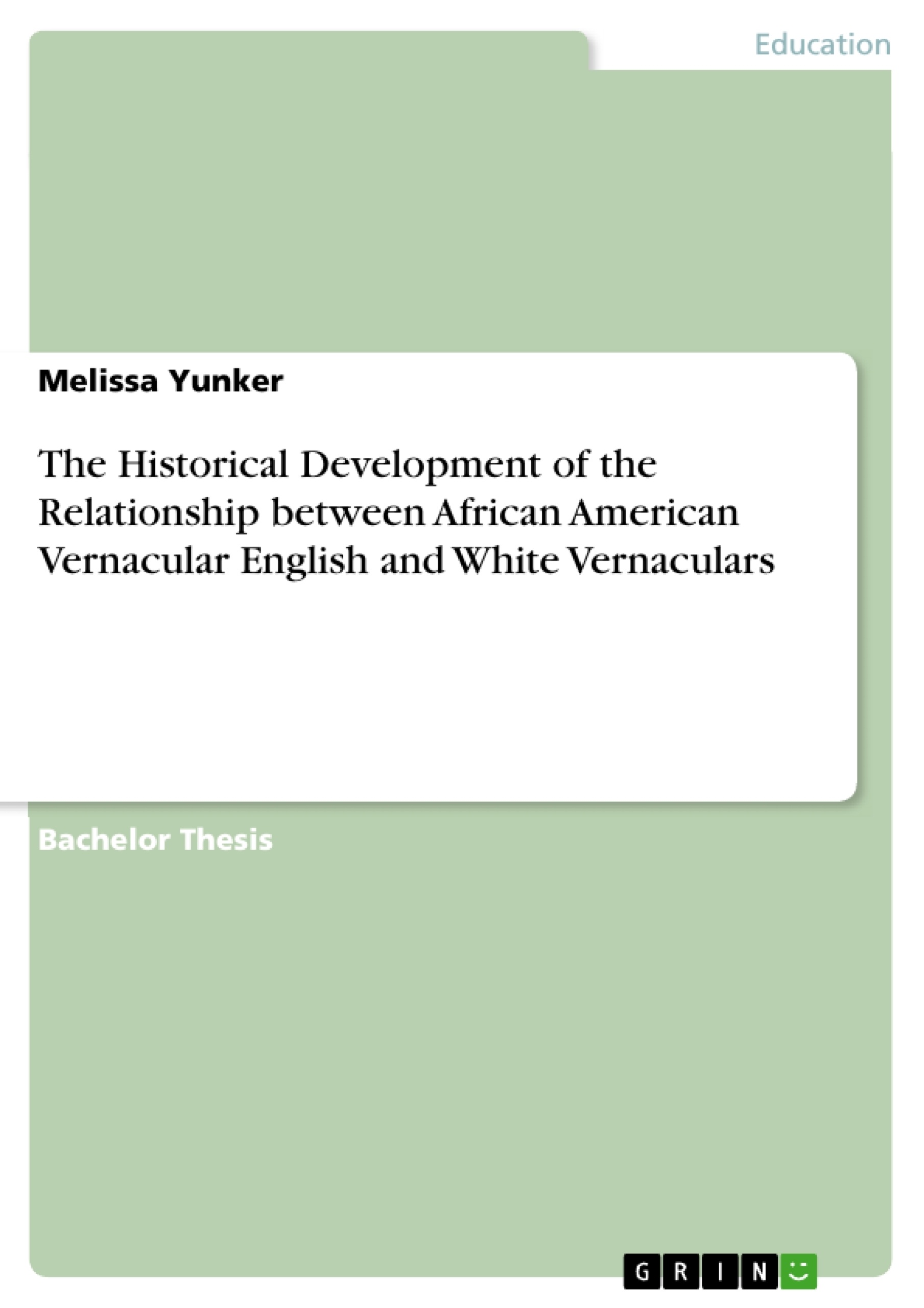African American Vernacular English (AAVE) is one of the most researched and controversially discussed varieties by sociolinguists. In this paper the controversial origin debate of AAVE will be discussed on the basis of the sociohistorical context and, more importantly, linguistic patterns. Following a chronological order, the way in which AAVE and Southern White Vernaculars (SWV) developed with respect to each other after slavery was abolished will be outlined after.
In the following chapter, the socioeconomic impacts of the Great Migration and Urbanization on the African American community will be laid out, as this historic development is essential in understanding contemporary sociolinguistic developments. These will finally be discussed by looking at a number of studies that focused on linguistic innovations and changes that occurred during the 1980’s in different parts of the country.
While the focus of this paper lies on AAVE, the development of a number of white vernaculars spoken both in the North as well as in the South of the US will be outlined and compared to AAVE as well. Linguistic structural features will be compared, put into their sociohistorical context and will therefore serve as a basis to describe the overall dynamics between white and black vernaculars.
Frequently asked questions
What is African American Vernacular English (AAVE)?
AAVE is a nonstandard, stigmatized variety of English with a concrete set of phonological, morphosyntactic, and lexical patterns. It's one of the most researched and controversially discussed varieties by sociolinguists.
What are the main theories regarding the origins of AAVE?
There are two main theories: the Creolist Hypothesis and the Anglicist Approach. The Creolist Hypothesis suggests AAVE descended from a creole language, similar to Gullah, with African substratum influences. The Anglicist Approach argues AAVE originated from learning early white vernaculars as a second language.
What is the Creolist Hypothesis?
The Creolist Hypothesis posits that AAVE originated as a creole language and has undergone decreolization, steadily assimilating to white vernaculars. It emphasizes the influence of West African languages on AAVE's grammatical structure.
What is the Anglicist Approach?
The Anglicist Approach claims that AAVE originated from learning early white vernaculars as a second language and is therefore a dialect of English, with language change patterns similar to other vernaculars.
What is the significance of Gullah in the context of AAVE's origins?
Gullah is an English-lexified creole spoken in coastal South Carolina and Georgia. It serves as a reference point for the Creolist Hypothesis, suggesting AAVE may have similar creole roots.
What is the role of the "zero copula" in the AAVE origin debate?
The absence of the copula verb "to be" in certain contexts is a key feature in the origin debate. Creolists argue it reflects African substrate influence, while Anglicists suggest it's an innovation or retention of older English forms.
What sociohistorical conditions influenced the development of AAVE after the Civil War?
Farm tenancy and the Great Migration played significant roles. Farm tenancy led to increased inter-ethnic contact and linguistic convergence between AAVE and Southern White Vernaculars (SWV). The Great Migration and subsequent segregation led to linguistic divergence.
What is the "divergence hypothesis"?
The divergence hypothesis argues that AAVE and Standard English are not converging but rather diverging due to factors like racial segregation and socioeconomic disparities.
What are some phonological features shared between AAVE and SWV?
Shared features include the loss of /r/ after consonants, front stressing of initial syllables, glide reduction, and certain vowel mergers.
What factors contributed to the Great Migration?
Factors included Jim Crow laws, racial violence, economic disadvantages in the South, and the demand for cheap labor in the North.
How did the Great Migration impact the linguistic development of AAVE?
The Great Migration resulted in de facto segregation and limited inter-ethnic contact. This has been linked to the divergence of AAVE from white vernaculars and the standardization of AAVE features across different regions.
What is the significance of the "Southern Vowel Shift" in the context of AAVE and SWV?
The Southern Vowel Shift is a series of vowel changes in Southern white speech. While SWV shows a general shift of various vowels, in Memphis, African Americans has been affected by the Southern Vowel Shift although to slightly different degrees than whites. This indicates both varieties are adapting to the vowel changes but with AAVE resisting features that might be closely linked with racial identity.
What are some contemporary structural developments in AAVE?
Recent changes in the tense and aspect system of AAVE show that they have developed unique structures such as reinterpreting verbal -s inflection to mark the historic present, with 'be done' used as direct consequence to a verb, quotative *be like", and stressed "stay' as a frequentative/habitual feature.
What are the counterarguments to the divergence hypothesis?
Some critics suggest the findings are due to flawed methodology, variable time depth, and age-grading. Also, research has displayed converging tendencies, indicating the opposite of the hypothesized development.
How do inter-ethnic contact situations affect the relationship between AAVE and white vernaculars?
Inter-ethnic contact can lead to linguistic assimilation, reversing the effects of divergence. However, the extent of assimilation depends on factors like peer influence, perceived prestige, and group identity.
Does social mobility affect the use of AAVE?
Yes. Studies show that individuals with greater social mobility are likely to code-switch and incorporate standard variants into their speech. This effect often depends on the context, purpose, and type of group affiliation.
Key themes in the preview.
The preview emphasizes the relationship between language, social factors like segregation and mobility, the ongoing debate surrounding AAVE's origins and linguistic structure, and the shifting identities of blacks and whites.
- Quote paper
- Melissa Yunker (Author), 2016, The Historical Development of the Relationship between African American Vernacular English and White Vernaculars, Munich, GRIN Verlag, https://www.grin.com/document/353218




